The #1 watering mistake beginner gardeners make is overwatering their plants. You might think your plants need a lot of water, but too much can drown them and lead to serious issues like yellow leaves and root rot. It’s essential to check the top inch of soil before watering. If it’s dry, then it’s time to water. Want to know more about watering effectively and preventing common mistakes? Keep exploring for more tips!
Key Takeaways
- The most common mistake is overwatering, resulting in yellowing leaves and root suffocation due to excess moisture.
- Beginners often fail to check soil moisture, leading to underwatering or overwatering plants.
- Using compacted or heavy soil can impede drainage, increasing the risk of root rot.
- Not adjusting the watering schedule based on seasonal changes and rainfall can harm plant health.
- Watering at the wrong times, such as midday, can increase evaporation and reduce moisture availability for plants.
Understanding Plant Watering Needs
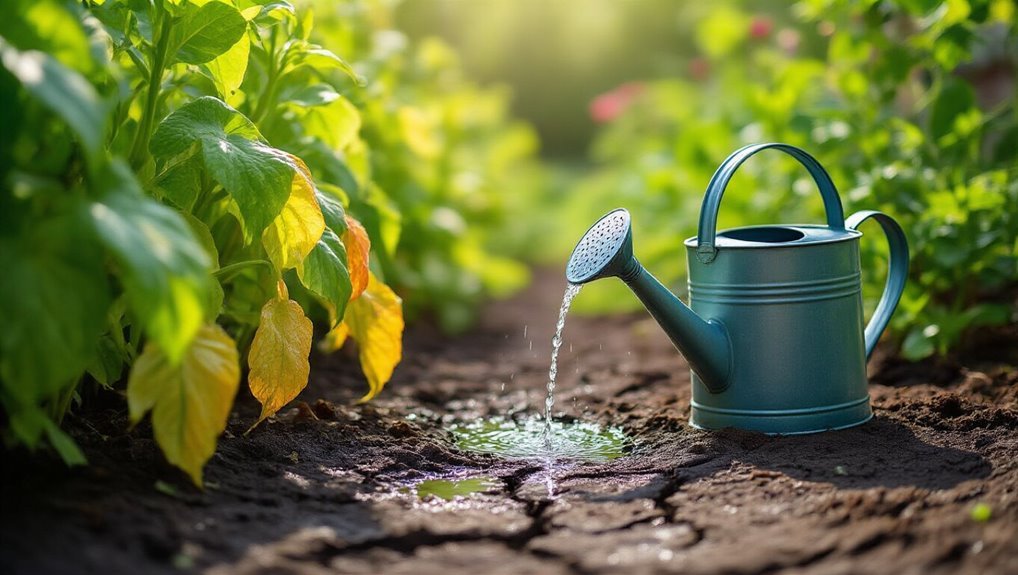
When you start gardening, it’s crucial to understand your plants’ watering needs, as improper watering can lead to stress or even death. Each plant species has its own requirements, so take the time to research them. Some thrive in moist soil, while others prefer drier conditions.
Pay attention to factors like climate, soil type, and pot size, as they all affect how quickly moisture evaporates. A good rule of thumb is to check the top inch of soil; if it’s dry, it’s time to water. Self-Watering Planters can help regulate moisture levels and prevent over- or under-watering, making them a practical option for gardeners seeking low-maintenance solutions.
Also, consider the time of day you water; early morning is best for minimizing evaporation and fungal issues. By tuning into your plants’ needs, you’ll help them flourish and grow strong. Using watering cans designed for gardening can help you deliver the right amount of moisture efficiently and directly to your plants’ roots.
Signs of Overwatering
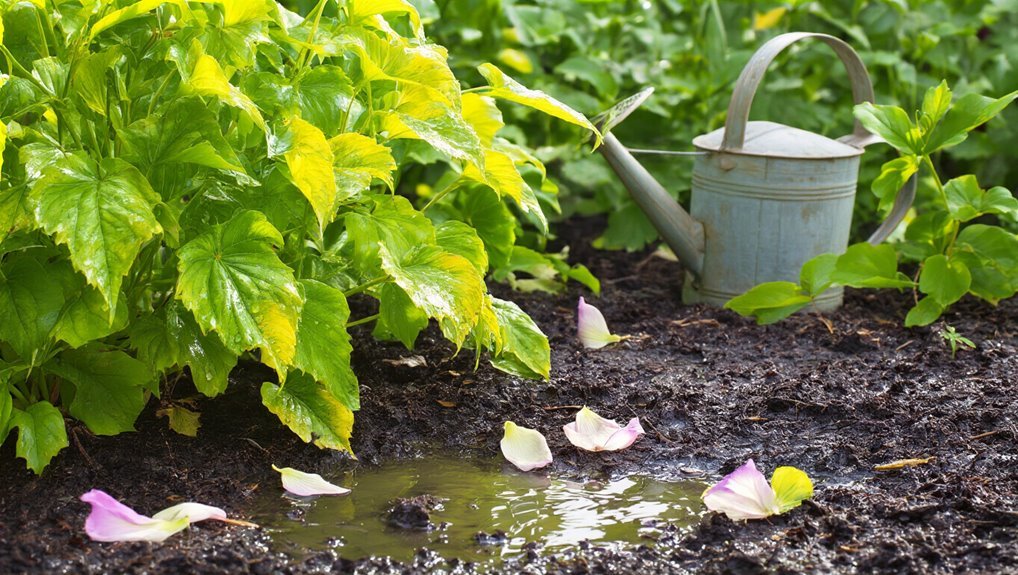
Although you might think that giving your plants extra water is helpful, it can actually lead to serious problems if you overdo it. For an easy solution, consider using plant watering systems that regulate moisture automatically.
Recognizing the signs of overwatering is crucial to keeping your plants healthy. Here are some key indicators to watch for:
- Yellowing Leaves: If the leaves start turning yellow, it’s a clear sign they’re drowning.
- Wilting: Surprisingly, overwatered plants can also wilt, as roots suffocate.
- Mold Growth: Seeing mold or mildew on the soil surface indicates too much moisture.
- Root Rot: Dark, mushy roots are a death sentence for your plants, signaling severe overwatering.
Using soil moisture sensors can help you avoid overwatering by giving you accurate measurements of the moisture levels in your garden soil.
The Importance of Soil Drainage
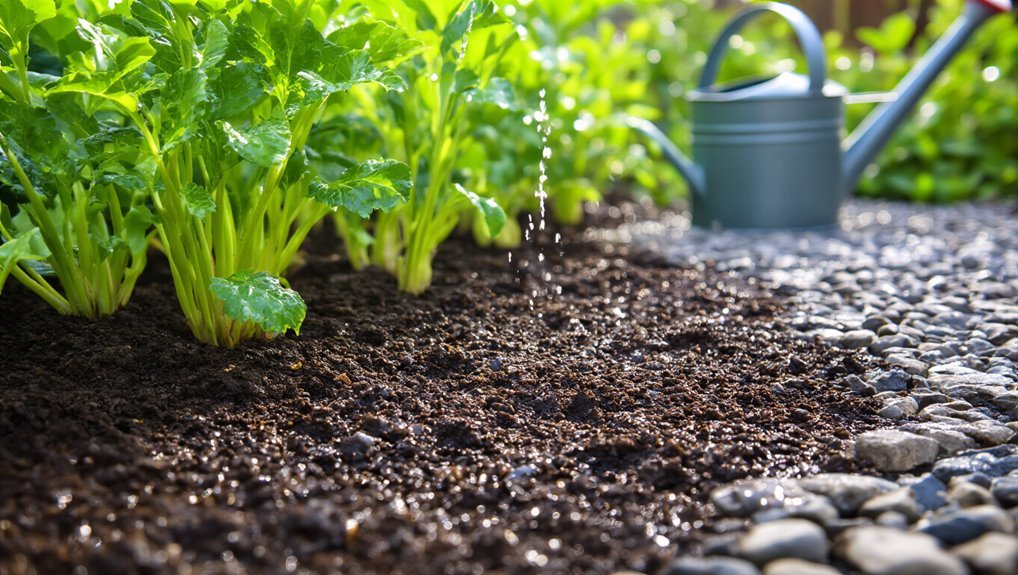
Good soil drainage is essential for healthy plants, as it prevents excess water from pooling around the roots.
When soil drains well, it allows oxygen to reach the roots, promoting strong growth and vitality. If you’ve got compacted or heavy soil, water may not flow freely, leading to root rot and other issues. Adding organic mulching materials like straw can also help regulate soil moisture and prevent surface compaction.
To improve drainage, consider mixing in organic matter like compost or using raised beds. You’ll want to check the drainage before planting; simply dig a hole and fill it with water. If it drains within a few hours, you’re good to go.
Choosing the right garden soil can further enhance drainage and create an ideal environment for your plants to thrive.
Establishing a Watering Schedule
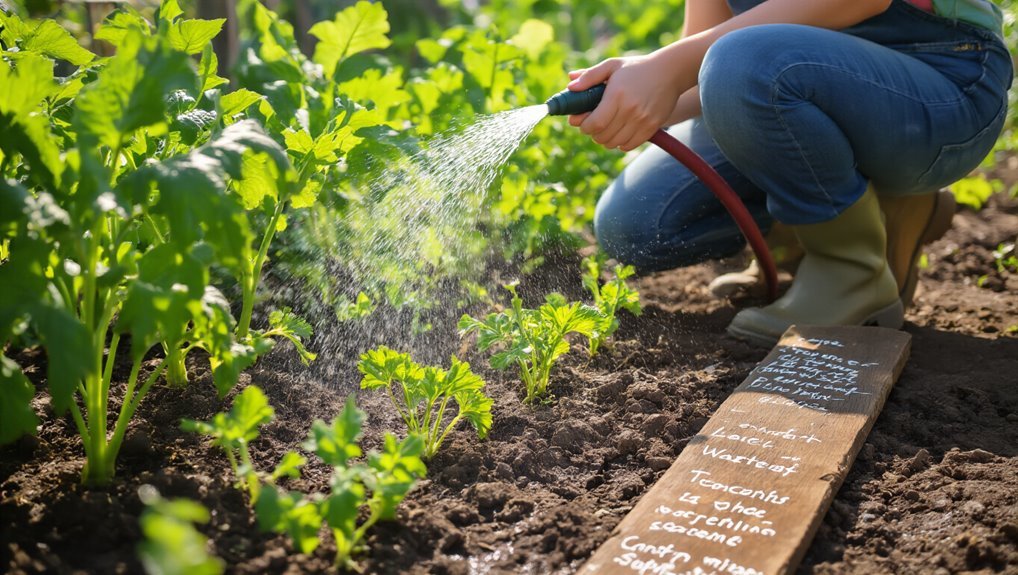
With well-drained soil in place, the next step is to establish a watering schedule that suits your garden’s needs.
A consistent routine keeps your plants healthy and thriving, so don’t overlook this crucial step. Here are some tips to help you create that schedule:
- Know your plants: Different species have varying water requirements; research their specific needs.
- Check the weather: Adjust your schedule based on rainfall and temperature; Mother Nature can help you out!
- Monitor soil moisture: Stick your finger in the soil—if it’s dry an inch down, it’s time to water.
- Water early or late: Avoid the heat of midday; early mornings or late evenings are ideal to minimize evaporation.
If you want an easy and effective way to water your garden evenly, consider using garden sprinklers to cover larger areas and keep your plants hydrated.
For even greater efficiency, consider using a drip irrigation system to deliver water directly to your plants’ roots while minimizing waste.
Your garden will thank you!
Techniques for Effective Watering
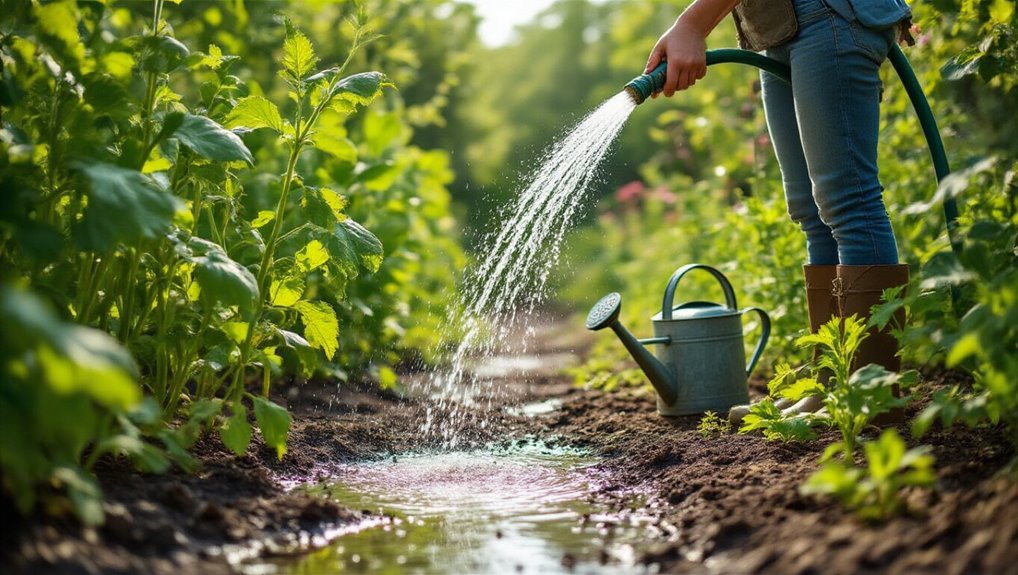
When you water your garden, using the right techniques can make all the difference in helping your plants thrive.
First, water early in the morning or late in the afternoon to minimize evaporation. Aim for deep, thorough watering rather than shallow sprinklings; this encourages roots to grow deeper.
Use a soaker hose or drip irrigation to deliver moisture directly to the soil, reducing waste and fungal disease risk. Pay attention to your plants’ needs—different species have varying water requirements.
Always check the soil moisture before watering; if it’s still damp an inch down, your plants don’t need more water yet.
Finally, avoid overhead watering to prevent wet leaves, which can lead to problems like mildew.
Tools to Help You Water Properly
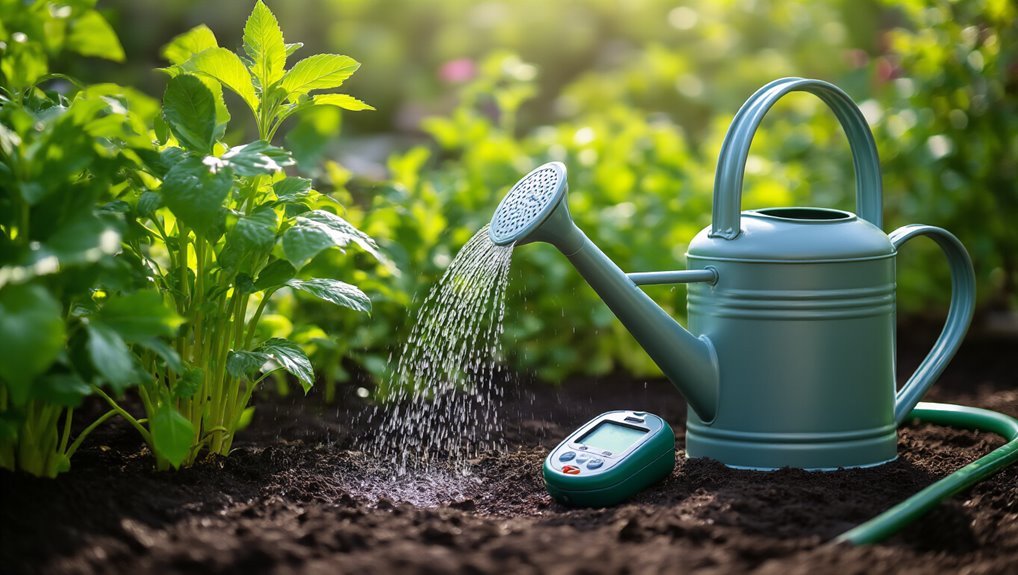
How can the right tools enhance your watering routine? Using the right equipment not only saves you time but also ensures your plants thrive.
Investing in proper tools makes your gardening experience more enjoyable and effective. Here are four essential tools to help you water properly:
- Soaker Hose: Delivers slow, deep watering directly to the roots, reducing evaporation.
- Watering Can: Perfect for precise watering in small garden areas or pots, preventing overwatering.
- Drip Irrigation System: Automates watering, conserving water and ensuring consistency.
- Moisture Meter: Helps you monitor soil moisture levels, guiding your watering schedule.
With these tools, you’ll feel more confident and connected to your garden, nurturing your plants like never before!
Adjusting Watering Based on Weather Conditions
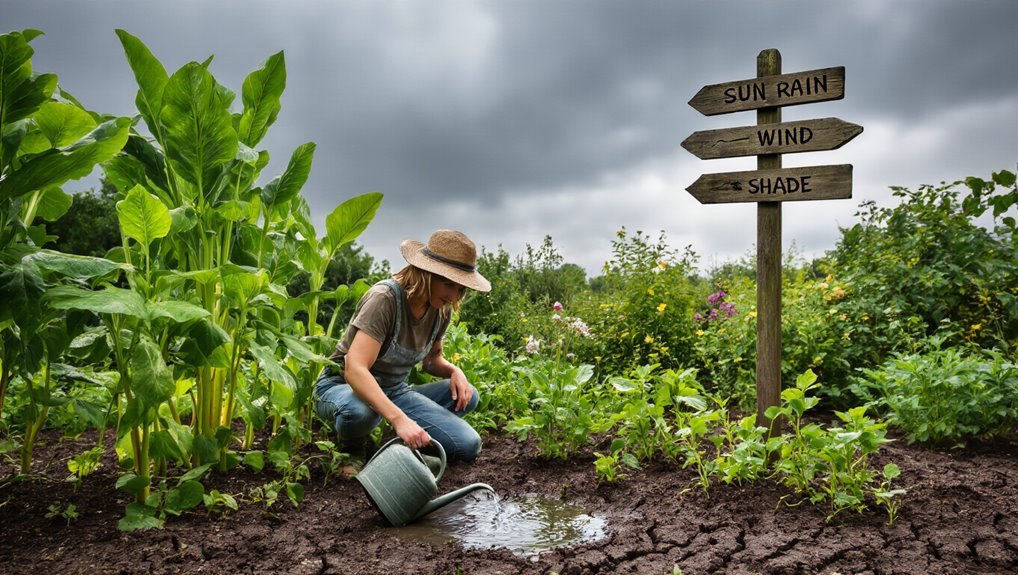
As weather conditions change, you need to adjust your watering routine to keep your plants healthy and thriving. Here’s a simple guide to help you tailor your watering based on the weather:
| Weather Condition | Watering Frequency | Notes |
|---|---|---|
| Sunny & Hot | Every 2-3 days | Check soil moisture regularly. |
| Cloudy & Humid | Every 4-5 days | Reduce watering; humidity retains moisture. |
| Rainy | As needed | Ensure good drainage; avoid overwatering. |
| Cool & Windy | Every 3-4 days | Wind can dry out soil; monitor closely. |
Tips for Specific Plant Types
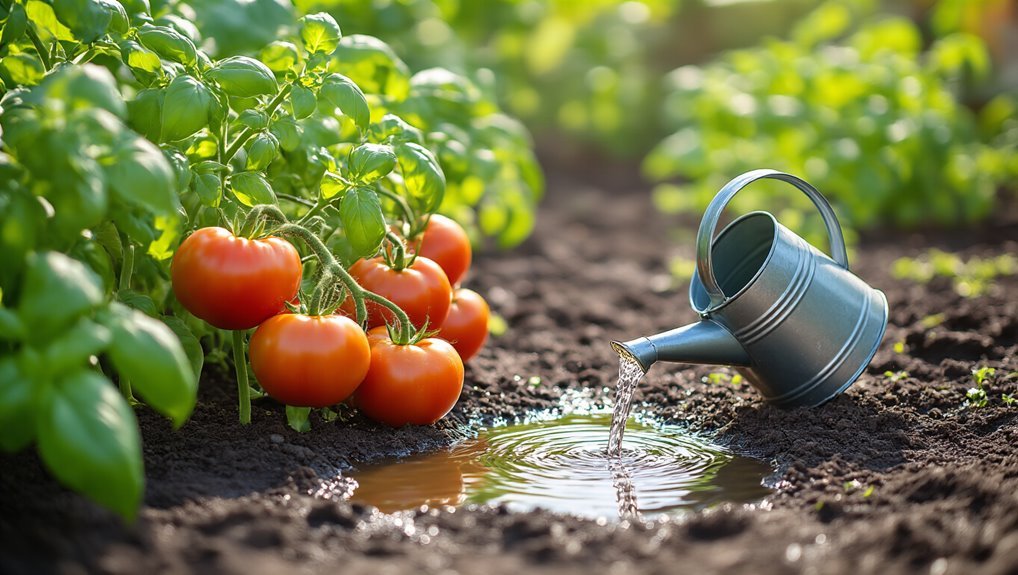
Understanding the specific needs of different plant types can make a significant difference in your watering routine. Each plant has unique requirements, and knowing these can help you avoid over or under-watering.
Here are some tips to guide you:
- Succulents: Water sparingly; they thrive in dry conditions. Check the soil’s moisture before watering.
- Ferns: Keep the soil consistently moist but not soggy. They love humidity, so misting is beneficial.
- Herbs: Most herbs prefer well-drained soil. Water when the top inch feels dry to the touch.
- Vegetables: They need regular watering; aim for deep, consistent moisture to encourage healthy growth.
Frequently Asked Questions
Can I Use Tap Water for My Plants?
Yes, you can use tap water for your plants. Just let it sit for a while to allow chlorine to dissipate. Your plants will thrive better with water that’s closer to room temperature.
How Can I Tell if My Soil Is Too Dry?
Imagine your soil as a thirsty traveler. If it feels dry and crumbly, cracks form, or plants droop, it’s likely too dry. Stick your finger in—if it’s parched, give your plants a drink!
What Time of Day Is Best for Watering?
The best time to water your plants is early morning or late afternoon. This way, you minimize evaporation and give your plants a chance to absorb moisture before the heat of the day sets in.
Should I Water My Plants During a Heatwave?
During a heatwave, your plants feel like they’re in a sauna. You should water them early in the morning or late in the evening, when temperatures cool, helping them absorb moisture without losing it to evaporation.
How Do I Know if My Plants Are Getting Enough Water?
To know if your plants are getting enough water, check the soil’s moisture by sticking your finger about an inch deep. If it feels dry, it’s time to water. Look for wilting leaves, too.
Conclusion
In your gardening journey, remember that watering wisely wins the day. By mastering the methods of moisture management and staying aware of your plants’ peculiar preferences, you’ll cultivate a thriving garden. Celebrate the satisfying sight of strong stems and vibrant leaves, as your careful care transforms your space into a lush landscape. So, sip slowly, soak deeply, and savor the success that sprouts from your newfound watering wisdom. Happy gardening!